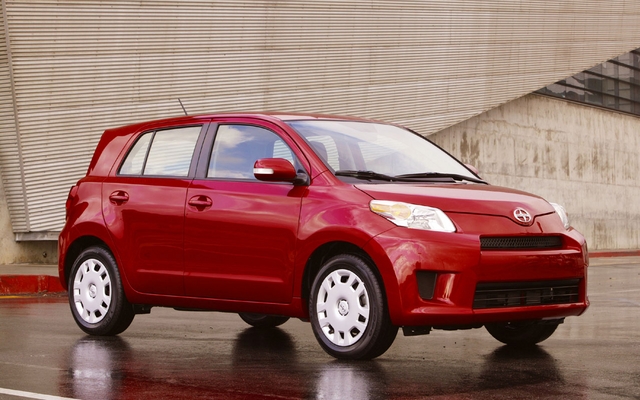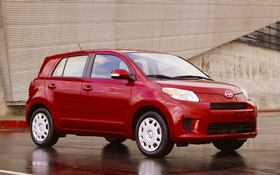2011 Scion xD: The TRD Redux

| Strong points |
|
|---|---|
| Weak points |
|
If you’ve ever tried your hand at vehicle modification, chances are that you’ve discovered precisely how well engineered some factory components can be. And for good reason; not only do manufacturers have far deeper pockets than any aftermarket manufacturer, but they also have the most to lose. Between costly recalls, warranty repairs, and the success of a brand’s reputation, it simply does not pay for a manufacturer to cut corners.
And it’s this very fact that has led to an impressive market that’s as old as hot rodding itself. From the days of dropping Buick V8s into lightweight Ford bodies to the current trend of sliding GM LS-engines into everything from old Volvos to Mazda RX7s, it’s a market that attracts millions of dollars every year. So it goes without saying that it was only a matter of time before auto manufacturers dove in with their own “aftermarket” parts. And few manufacturers may be better suited to this than Scion. Chasing down the elusive youth market in a manner that is unmatched in the automotive marketplace, the inclusion of a lengthy TRD parts catalog allows would-be buyers to give their car a degree of individuality and added performance without risking damage, or their warranty.
And perhaps no vehicle can benefit from some added performance quite like the xD. Having already tested this vehicle just weeks ago, it’s complete lack of performance chops and ability to seemingly repel traction was still fresh in my mind as I approached the much different looking TRD-equipped version that awaited me. Gone were the piddly little steel wheels hiding behind wheel covers, replaced by very racy looking multi-spoke wheels. The stance, once a little too tall, was much more hunkered down over the new wheel and tire combination, and poking out from the rear; a TRD-branded exhaust tip indicating the presence of an optional sports exhaust system.
Inside, the first indication of the car’s revised suspension came upon lowering myself into the driver’s seat and feeling the familiar lack of suspension compression that typically denotes some serious sporting pedigree. Looking around the cabin, all the same components are laid out in precisely the same manner, with just a TRD-branded billet aluminum shift knob to separate this xB from the unadorned model I had become familiar with. Achingly cold to the touch in mid-January, the TRD-bedecked shifter moves in a relatively large pattern through five somewhat vague shift gates; obviously the only change is to the knob itself, not the shifter mechanism.
Cajoled into neutral, clutch depressed, and ignition occurs just as it does with all other Toyota vehicles: quickly. But once the start motor has disengaged the flywheel, it’s quite apparent that the chrome-tipped sports exhaust isn’t just another pretty face. During its cold start sequence, the car drones like so many buzzing bees, making its presence known without intruding too much. Once it settles down to its normal idle, it becomes only slightly more perceptible than its more pedestrian counterpart. But, prod the gas pedal, and the volume increases precisely as you’d expect. Off idle, the engine revs freely and sounds quite tight overall, and the revs drop equally fast. This responsiveness makes the well-weighted clutch easy to modulate, and the auditory feedback from the exhaust really makes pulling away a breeze.
Of course, for all its audible bluster, there no getting around the car’s 125 horsepower and 125 pound feet of torque. Accelerating reasonably quickly, the five forward gears do help keep the car in between the 4,400 rpm torque peak and the 6,000 rpm horsepower peak, but there isn’t a dramatic sense of urgency in its forward progress once you’re through second gear. But although the accelerative properties remain largely the same, the handling experience is one that’s significantly (and blessedly) better than the stock model.
Perhaps it’s simply the larger tires and wheel, or perhaps it’s the stiffer stabilizer bars and springs, but this xD is head and shoulders ahead of the standard model when it came to tackling curves. Although still not endowed with what I’d call excessive traction, the limits are vastly higher, and there’s far, far more feedback to advise you of the grip available. Where the standard xD slithered and surprised with exceedingly horrific understeer, this one carves a neat and tidy line, feeling quite spry by comparison. Still feeling quite susceptible to fore-aft weight transfer, the most aggressive techniques will light up the stability control system, but it’s not the same sort of “oh crap” moment you fear in the typical xD. Instead, you find yourself leaning on the car harder and harder in an effort to meet and exceed its limits for fun, without trepidation or fear that doing so may bring about your ultimate demise.
But it’s not all gravy. As one would expect of an aftermarket sports-infused suspension system, the TRD goodies available for the xD are quite firm, and it does impinge upon the ride quality. Sure, on well-paved highways and suburban streets are fine and dandy, but nailing that occasional mid-span, bridge-borne pothole is jarring to a degree that leaves you wondering if you haven’t flattened a wheel. Likewise, speed bumps and low-speed irregularities are equally punishing, and require serious retardation… at least the brakes are good for it.
But for all its quirks, I’d still say that the TRD improvements available for this particular vehicle represent significant improvements that, for the most part, make it an eminently better vehicle. Sure, the ride is a little rough and the exhaust note would grow tiresome after lord knows how many hours at the wheel, but for the average commuter, it’s a far more capable vehicle, and even more important, way more fun.











